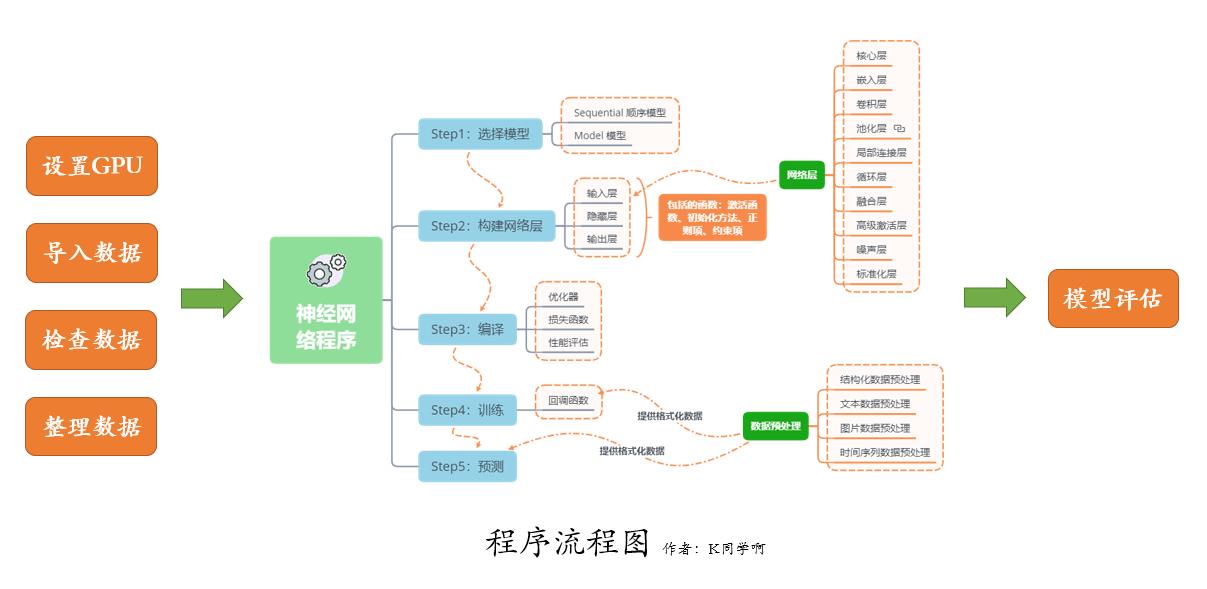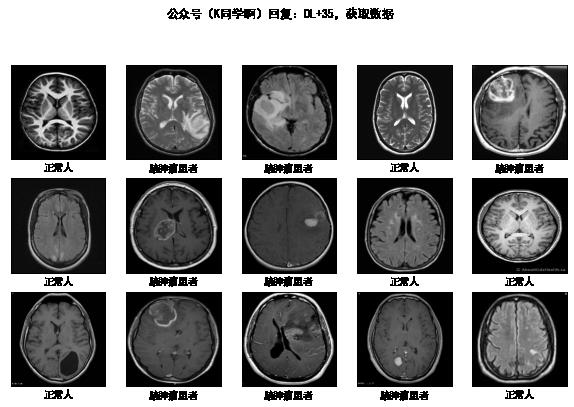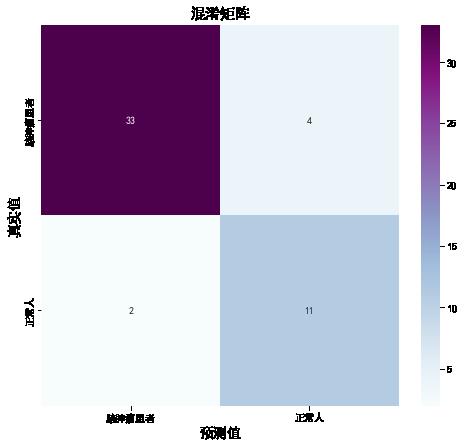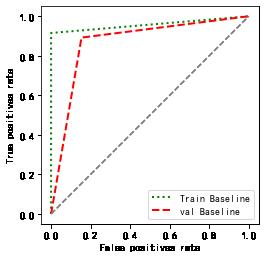脑肿瘤识别,毕设找上门来了
Posted K同学啊
tags:
篇首语:本文由小常识网(cha138.com)小编为大家整理,主要介绍了脑肿瘤识别,毕设找上门来了相关的知识,希望对你有一定的参考价值。
本文已加入 🚀 Python AI 计划,从一个Python小白到一个AI大神,你所需要的所有知识都在 这里 了。
大家好,我是『K同学啊』!
今天我将带大家探索一下深度学习在医学领域的应用–脑肿瘤识别,脑肿瘤也称为颅内肿瘤,是颅内占位性病变的主要疾病,在儿童易患的恶性病变中仅次于白血病,位于第二位。有数据表明,我国每年新增儿童脑瘤患者7000~8000名,其中70%~80%的患儿肿瘤呈恶性。由于脑肿瘤患者年龄越小,发病速度越快,肿瘤恶性程度越高,所以早期发现。治疗成为降低疾病危害的重要方式之一。
这次我们一共用到了253张脑部扫描图片数据,其中患有脑肿瘤的患者脑部扫描图片155张,正常人的脑部扫描图片98张。使用的算法为MobileNetV2,最后的识别准确率是90.0%,AUC值为0.869。
本次的重点: 相对于《深度学习100例》以往的案例,本次我们将加入AUC评价指标来评估脑肿瘤识别的识别效果,AUC(Area under the Curve of ROC)是ROC曲线下方的面积,是判断二分类预测模型优劣的标准。
我的环境:
- 语言环境:Python3.8
- 编译器:Jupyter lab
- 深度学习环境:TensorFlow2.4.1
我们的代码流程图如下所示:

一、设置GPU
import tensorflow as tf
gpus = tf.config.list_physical_devices("GPU")
if gpus:
gpu0 = gpus[0] #如果有多个GPU,仅使用第0个GPU
tf.config.experimental.set_memory_growth(gpu0, True) #设置GPU显存用量按需使用
tf.config.set_visible_devices([gpu0],"GPU")
import matplotlib.pyplot as plt
import os,PIL,pathlib
import numpy as np
import pandas as pd
import warnings
from tensorflow import keras
warnings.filterwarnings("ignore") #忽略警告信息
plt.rcParams['font.sans-serif'] = ['SimHei'] # 用来正常显示中文标签
plt.rcParams['axes.unicode_minus'] = False # 用来正常显示负号
二、导入数据
1. 导入数据
import pathlib
data_dir = "./35-day-brain_tumor_dataset"
data_dir = pathlib.Path(data_dir)
image_count = len(list(data_dir.glob('*/*')))
print("图片总数为:",image_count)
图片总数为: 253
batch_size = 16
img_height = 224
img_width = 224
"""
关于image_dataset_from_directory()的详细介绍可以参考文章:https://mtyjkh.blog.csdn.net/article/details/117018789
"""
train_ds = tf.keras.preprocessing.image_dataset_from_directory(
data_dir,
validation_split=0.2,
subset="training",
seed=12,
image_size=(img_height, img_width),
batch_size=batch_size)
Found 253 files belonging to 2 classes.
Using 203 files for training.
"""
关于image_dataset_from_directory()的详细介绍可以参考文章:https://mtyjkh.blog.csdn.net/article/details/117018789
"""
val_ds = tf.keras.preprocessing.image_dataset_from_directory(
data_dir,
validation_split=0.2,
subset="validation",
seed=12,
image_size=(img_height, img_width),
batch_size=batch_size)
Found 253 files belonging to 2 classes.
Using 50 files for validation.
class_names = train_ds.class_names
print(class_names)
['no', 'yes']
2. 检查数据
for image_batch, labels_batch in train_ds:
print(image_batch.shape)
print(labels_batch.shape)
break
(16, 224, 224, 3)
(16,)
3. 配置数据集
- shuffle() : 打乱数据,关于此函数的详细介绍可以参考:https://zhuanlan.zhihu.com/p/42417456
- prefetch() : 预取数据,加速运行,其详细介绍可以参考我前两篇文章,里面都有讲解。
- cache() : 将数据集缓存到内存当中,加速运行
AUTOTUNE = tf.data.AUTOTUNE
def train_preprocessing(image,label):
return (image/255.0,label)
train_ds = (
train_ds.cache()
.shuffle(1000)
.map(train_preprocessing) # 这里可以设置预处理函数
# .batch(batch_size) # 在image_dataset_from_directory处已经设置了batch_size
.prefetch(buffer_size=AUTOTUNE)
)
val_ds = (
val_ds.cache()
.shuffle(1000)
.map(train_preprocessing) # 这里可以设置预处理函数
# .batch(batch_size) # 在image_dataset_from_directory处已经设置了batch_size
.prefetch(buffer_size=AUTOTUNE)
)
4. 数据可视化
plt.figure(figsize=(10, 8)) # 图形的宽为10高为5
plt.suptitle("公众号(K同学啊)回复:DL+35,获取数据")
class_names = ["脑肿瘤患者","正常人"]
for images, labels in train_ds.take(1):
for i in range(15):
plt.subplot(4, 5, i + 1)
plt.xticks([])
plt.yticks([])
plt.grid(False)
# 显示图片
plt.imshow(images[i])
# 显示标签
plt.xlabel(class_names[labels[i]-1])
plt.show()

三、构建模型
from tensorflow.keras import layers, models, Input
from tensorflow.keras.models import Model
from tensorflow.keras.layers import Conv2D, MaxPooling2D, Dense, Flatten, Dropout,BatchNormalization,Activation
# 加载预训练模型
base_model = tf.keras.applications.mobilenet_v2.MobileNetV2(weights='imagenet',
include_top=False,
input_shape=(img_width,img_height,3),
pooling='max')
for layer in base_model.layers:
layer.trainable = True
X = base_model.output
"""
注意到原模型(MobileNetV2)会发生过拟合现象,这里加上一个Dropout层
加上后,过拟合现象得到了明显的改善。
大家可以试着通过调整代码,观察一下注释Dropout层与不注释之间的差别
"""
X = Dropout(0.4)(X)
output = Dense(len(class_names), activation='softmax')(X)
model = Model(inputs=base_model.input, outputs=output)
# model.summary()
四、编译
model.compile(optimizer="adam",
loss='sparse_categorical_crossentropy',
metrics=['accuracy'])
五、训练模型
from tensorflow.keras.callbacks import ModelCheckpoint, Callback, EarlyStopping, ReduceLROnPlateau, LearningRateScheduler
NO_EPOCHS = 50
PATIENCE = 10
VERBOSE = 1
# 设置动态学习率
annealer = LearningRateScheduler(lambda x: 1e-3 * 0.99 ** (x+NO_EPOCHS))
# 设置早停
earlystopper = EarlyStopping(monitor='val_acc', patience=PATIENCE, verbose=VERBOSE)
#
checkpointer = ModelCheckpoint('best_model.h5',
monitor='val_accuracy',
verbose=VERBOSE
save_best_only=True,
save_weights_only=True)
train_model = model.fit(train_ds,
epochs=NO_EPOCHS,
verbose=1,
validation_data=val_ds,
callbacks=[earlystopper, checkpointer, annealer])
Epoch 1/50
13/13 [==============================] - 7s 145ms/step - loss: 3.1000 - accuracy: 0.6700 - val_loss: 1.7745 - val_accuracy: 0.6400
WARNING:tensorflow:Early stopping conditioned on metric `val_acc` which is not available. Available metrics are: loss,accuracy,val_loss,val_accuracy
......
Epoch 49/50
13/13 [==============================] - 1s 60ms/step - loss: 3.0536e-08 - accuracy: 1.0000 - val_loss: 2.6647 - val_accuracy: 0.8800
WARNING:tensorflow:Early stopping conditioned on metric `val_acc` which is not available. Available metrics are: loss,accuracy,val_loss,val_accuracy
Epoch 00049: val_accuracy did not improve from 0.90000
Epoch 50/50
13/13 [==============================] - 1s 60ms/step - loss: 1.4094e-08 - accuracy: 1.0000 - val_loss: 2.6689 - val_accuracy: 0.8800
WARNING:tensorflow:Early stopping conditioned on metric `val_acc` which is not available. Available metrics are: loss,accuracy,val_loss,val_accuracy
Epoch 00050: val_accuracy did not improve from 0.90000
六、模型评估
1. 混淆矩阵
from sklearn.metrics import confusion_matrix
import seaborn as sns
import pandas as pd
# 定义一个绘制混淆矩阵图的函数
def plot_cm(labels, predictions):
# 生成混淆矩阵
conf_numpy = confusion_matrix(labels, predictions)
# 将矩阵转化为 DataFrame
conf_df = pd.DataFrame(conf_numpy, index=class_names ,columns=class_names)
plt.figure(figsize=(8,7))
sns.heatmap(conf_df, annot=True, fmt="d", cmap="BuPu")
plt.title('混淆矩阵',fontsize=15)
plt.ylabel('真实值',fontsize=14)
plt.xlabel('预测值',fontsize=14)
val_pre = []
val_label = []
for images, labels in val_ds:#这里可以取部分验证数据(.take(1))生成混淆矩阵
for image, label in zip(images, labels):
# 需要给图片增加一个维度
img_array = tf.expand_dims(image, 0)
# 使用模型预测图片中的人物
prediction = model.predict(img_array)
val_pre.append(class_names[np.argmax(prediction)])
val_label.append(class_names[label])
plot_cm(val_label, val_pre)

2. 各项指标评估
from sklearn import metrics
def test_accuracy_report(model):
print(metrics.classification_report(val_label, val_pre, target_names=class_names))
score = model.evaluate(val_ds, verbose=0)
print('Loss function: %s, accuracy:' % score[0], score[1])
test_accuracy_report(model)
precision recall f1-score support
脑肿瘤患者 0.94 0.89 0.92 37
正常人 0.73 0.85 0.79 13
accuracy 0.88 50
macro avg 0.84 0.87 0.85 50
weighted avg 0.89 0.88 0.88 50
Loss function: 2.668877601623535, accuracy: 0.8799999952316284
3. AUC 评价
一句话介绍:AUC(Area under the Curve of ROC)是ROC曲线下方的面积,是判断二分类预测模型优劣的标准。
- AUC = 1:是完美分类器,绝大多数预测的场合,不存在完美分类器。
- 0.5 < AUC < 1:优于随机猜测。
- AUC = 0.5:跟随机猜测一样(例:丢硬币),模型没有预测价值。
- AUC < 0.5:比随机猜测还差。
ROC曲线的横坐标是伪阳性率(也叫假正类率,False Positive Rate),纵坐标是真阳性率(真正类率,True Positive Rate),相应的还有真阴性率(真负类率,True Negative Rate)和伪阴性率(假负类率,False Negative Rate)。这四类的计算方法如下:
- 伪阳性率(FPR):在所有实际为阴性的样本中,被错误地判断为阳性的比率。
- 真阳性率(TPR):在所有实际为阳性的样本中,被正确地判断为阳性的比率。
- 伪阴性率(FNR):在所有实际为阳性的样本中,被错误的预测为阴性的比率。
- 真阴性率(TNR):在所有实际为阴性的样本中,被正确的预测为阴性的比率。
val_pre = []
val_label = []
for images, labels in val_ds:#这里可以取部分验证数据(.take(1))生成混淆矩阵
for image, label in zip(images, labels):
# 需要给图片增加一个维度
img_array = tf.expand_dims(image, 0)
# 使用模型预测图片中的人物
prediction = model.predict(img_array)
val_pre.append(np.argmax(prediction))
val_label.append(label)
train_pre = []
train_label = []
for images, labels in train_ds:#这里可以取部分验证数据(.take(1))生成混淆矩阵
for image, label in zip(images, labels):
# 需要给图片增加一个维度
img_array = tf.expand_dims(image, 0)
# 使用模型预测图片中的人物
prediction = model.predict(img_array)
train_pre.append(np.argmax(prediction))
train_label.append(label)
sklearn.metrics.roc_curve():用于绘制ROC曲线
主要参数:
y_true:真实的样本标签,默认为0,1或者-1,1。如果要设置为其它值,则 pos_label 参数要设置为特定值。例如要令样本标签为1,2,其中2表示正样本,则pos_label=2。y_score:对每个样本的预测结果。pos_label:正样本的标签。
返回值:
fpr:False positive rate。tpr:True positive rate。thresholds
def plot_roc(name, labels, predictions, **kwargs):
fp, tp, _ = metrics.roc_curve(labels, predictions)
plt.plot(fp, tp, label=name, linewidth=2, **kwargs)
plt.plot([0, 1], [0, 1], color='gray', linestyle='--')
plt.xlabel('False positives rate')
plt.ylabel('True positives rate')
ax = plt.gca()
ax.set_aspect('equal')
plot_roc("Train Baseline", train_label, train_pre, color="green", linestyle=':')
plot_roc("val Baseline", val_label, val_pre, color="red", linestyle='--')
plt.legend(loc='lower right')

auc_score = metrics.roc_auc_score(val_label, val_pre)
print("AUC值为:",auc_score)
AUC值为: 0.869022869022869
🥇 需要 项目定制、毕设辅导 的同学可以加我V.信:mtyjkh_
以上是关于脑肿瘤识别,毕设找上门来了的主要内容,如果未能解决你的问题,请参考以下文章
《java精品毕设》基于javaweb宠物领养平台管理系统(源码+毕设论文+sql):主要实现:个人中心,信息修改,填写领养信息,交流论坛,新闻,寄养信息,公告,宠物领养信息,我的寄养信息等(代码片段